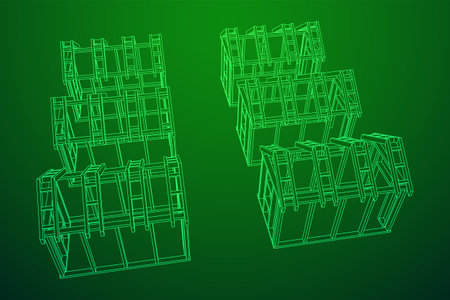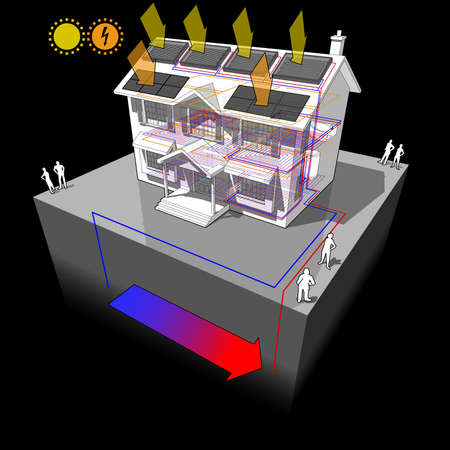1. Understanding Feng Shui Principles in a Modern American Home
Feng Shui, an ancient Chinese practice, focuses on balancing energy (or “chi”) to create harmony and well-being in the home. While traditional Feng Shui was designed with classic Asian architectural layouts in mind, its core concepts can be adapted to fit the unique styles of American homes, including open-concept designs, split-level houses, and other popular floor plans.
What Is Feng Shui?
At its heart, Feng Shui is about arranging your environment to support positive energy flow. This often means thoughtful placement of furniture and décor—including plants—to encourage health, prosperity, and happiness. In the context of American homes, this means adapting age-old wisdom to modern spaces while still respecting the spirit of the tradition.
Integrating Feng Shui with American Floor Plans
Many American homes feature layouts that differ from those commonly found in Asia. Open-concept living spaces, split-levels, ranch-style homes, and multi-story townhouses are just some examples. Each presents unique opportunities and challenges for implementing Feng Shui principles.
Common American Floor Plan Features & Feng Shui Adaptations
| Floor Plan Type | Key Features | Feng Shui Consideration |
|---|---|---|
| Open-Concept Layout | Few walls between living, dining, and kitchen areas | Create “zones” with furniture or rugs to guide chi; use plants as natural dividers without blocking pathways |
| Split-Level Home | Multiple levels connected by short flights of stairs | Place plants near stairways to soften sharp energy shifts; avoid cluttering landings to keep energy flowing smoothly |
| Traditional Ranch-Style | Single-story, horizontal layout | Use plants to anchor entryways and corners; ensure there’s a clear line of sight from front door through main living space for welcoming energy |
| Multi-Story Townhouse | Narrow footprint with multiple floors | Add greenery near staircases and windows; avoid blocking pathways or overcrowding small rooms with large plants |
The Role of Plants in Feng Shui for American Homes
Plants are powerful tools in Feng Shui because they symbolize life, growth, and fresh energy. The right plant placement can enhance specific areas of your home—like boosting family harmony in the living room or promoting prosperity near the entrance. However, it’s important to match plant types and positions with both the principles of Feng Shui and the realities of your home’s design.
2. Best Plants for Feng Shui and Where to Place Them
Choosing the right plants and putting them in the perfect spot can help boost positive energy, improve air quality, and make your American home feel more inviting. Below are some of the best indoor plants for Feng Shui and tips on where to place them in your living room, kitchen, and entryway.
Top Feng Shui Indoor Plants
| Plant | Feng Shui Benefit | Ideal Placement |
|---|---|---|
| Lucky Bamboo | Attracts good luck and harmony | Entryway or living room corner |
| Money Tree (Pachira Aquatica) | Brings wealth and prosperity | Near the front door or in the living room |
| Snake Plant (Sansevieria) | Cleanses air, brings protective energy | Entryway, living room corners, or kitchen window |
| Peace Lily | Purifies air, encourages calmness and balance | Living room or kitchen counter (avoid direct sunlight) |
| Jade Plant (Crassula ovata) | Symbolizes growth and renewal | Northeast area of entryway or office space |
| Pothos (Devil’s Ivy) | Absorbs toxins, boosts positive vibes | High shelves in the living room or kitchen cabinets |
| Boston Fern | Adds life energy (chi) and humidity | Living room bookshelf or bathroom corner with light |
Where to Place Your Feng Shui Plants in American Homes
Living Room Dos:
- Place a Money Tree near a bright window but not in direct sun to attract abundance.
- Add a Peace Lily on a side table to promote harmony for family gatherings.
- Pothos on high shelves keeps energy flowing and freshens up the space.
Kitchen Dos:
- A small Snake Plant on a windowsill helps purify cooking fumes and brings strong protective energy.
- Basil or other fresh herbs by the sink add both practical and Feng Shui benefits—growth and nourishment.
Entryway Dos:
- Lucky Bamboo by the entrance welcomes guests with positive chi right at your front door.
- A Jade Plant just inside your entryway is believed to invite wealth into your home.
American Floor Plan Tips:
- Avoid placing big plants right in front of doors as this can block good energy from entering.
- If you have an open concept layout, use tall plants like Snake Plant as natural dividers to subtly guide energy flow without blocking light or pathways.
Selecting these plants thoughtfully for each area of your home helps create a balanced environment that aligns with both Feng Shui principles and modern American lifestyles.

3. Common Mistakes: Feng Shui Plant Placement Don’ts
When it comes to incorporating Feng Shui principles into American homes, it’s easy to make a few common mistakes with plant placement. These errors can disrupt the energy flow (Chi) in your living spaces and reduce the positive effects you’re hoping to achieve. Let’s review some frequent missteps and how they impact your home’s energy.
Don’t Block Walkways or Entryways
In many American floor plans, open entryways and hallways are essential for movement and energy circulation. Placing large plants or heavy planters in these areas can block both physical pathways and the smooth flow of Chi, making your home feel cramped or stagnant.
| Location | Why Avoid? |
|---|---|
| Front Door Area | Blocks welcoming energy and may create an uninviting first impression. |
| Main Hallway | Obstructs both movement and natural energy flow throughout the home. |
Avoid Placing Plants in Bedrooms
While houseplants add beauty, placing them in bedrooms is generally discouraged in Feng Shui. Plants release oxygen during the day but switch to carbon dioxide at night, which may impact sleep quality. Energetically, too many plants can also overstimulate what should be a restful space.
| Bedroom Plant Placement | Potential Impact |
|---|---|
| Near the Bed | Can disrupt rest and relaxation by adding active energy. |
| Crowded Corners | Makes the room feel cluttered and restless. |
Don’t Overcrowd Living Spaces with Plants
It’s tempting to fill every available spot with greenery, especially with open-concept layouts popular in many American homes. However, overcrowding leads to clutter and blocks energy circulation. Instead, choose a few healthy plants placed intentionally for best results.
Quick Reference: Common Plant Placement Errors
| Mistake | Description | Impact on Energy Flow |
|---|---|---|
| Plants blocking doorways or halls | Obstructs paths for people and energy | Stagnant or sluggish Chi, feeling of congestion |
| Too many plants in one area | Crowds corners or surfaces | Cluttered energy, increased stress levels |
| Plants in bedrooms | Adds yang (active) energy where yin (restful) is needed | Poor sleep quality, restless environment |
| Dead or unhealthy plants left inside | Lack of maintenance or care for greenery | Attracts negative Chi, reduces positive vibes in the home |
Avoid Sharp or Spiky Plants Indoors
Cacti and other spiky plants are trendy but can introduce harsh “Sha Chi” (negative energy) indoors, particularly if placed near seating areas or high-traffic spots. Opt for soft-leaved varieties instead for a more harmonious atmosphere.
Tip:
If you love succulents, place them outside or in less-used rooms to minimize energetic disruption.
4. Feng Shui Tips for Small Apartments and Open Spaces
Living in a small apartment, loft, or an open-plan home is common in the U.S., especially in urban areas. While these layouts offer flexibility, they can also present challenges for applying Feng Shui principles—especially when it comes to placing plants. Here are some easy-to-follow tips and practical ideas for making the most of your space while boosting positive energy and style.
Best Plant Placement Ideas for Compact Spaces
- Choose Space-Saving Plants: Opt for upright or trailing plants like snake plant, pothos, or peace lily. These varieties thrive indoors and don’t take up much floor space.
- Go Vertical: Use wall-mounted planters, hanging pots, or tall shelves to display greenery without cluttering your limited square footage.
- Create “Zones” With Plants: In open living spaces, use larger potted plants or groups of smaller ones to subtly define areas like the living room, dining area, or workspace.
- Let There Be Light: Position plants near windows but avoid blocking pathways. This keeps energy (or chi) flowing smoothly through your home.
Plant Placement Dos and Don’ts Table
| Do | Don’t |
|---|---|
| Use small or medium plants on shelves or counters | Avoid crowding many large plants in one spot |
| Place a healthy plant by the entryway to welcome good energy | Don’t put spiky plants (like cacti) near relaxation zones |
| Select air-purifying species for kitchens and bathrooms | Avoid dead or dying plants anywhere—they block positive flow |
| Rotate plants seasonally for variety and balance | Don’t block windows or doors with pots or stands |
| Use matching pots for a cohesive look in open layouts | Avoid placing too many different plant types together; it can feel chaotic |
Special Considerations for Lofts & Open-Plan Homes
- Add Height: Use tall plants like fiddle leaf figs or bamboo palms to fill vertical space and soften sharp architectural edges common in lofts.
- Corners Matter: Place a lush plant in empty corners to disperse stagnant energy and create a cozy vibe.
- Smooth Energy Flow: Ensure there’s always a clear path between furniture and greenery—plants should enhance movement, not hinder it.
- No Greenery Overload: Balance is key; too many plants can overwhelm a small area. Stick to a few well-chosen pieces for maximum effect.
Quick Feng Shui Plant Checklist for Small Spaces
- Select compact or multi-purpose plant stands
- Aim for even distribution—avoid clustering all greens in one corner
- Keep leaves clean and healthy for optimal energy flow
- Add pops of green to neutral American décor for freshness and harmony
- If you have pets, double-check that your plant choices are non-toxic!
5. Seasonal and Cultural Adaptations
Adapting Feng Shui plant placement for American homes means considering both the changing seasons and the rich variety of cultural traditions. By choosing plants and arrangements that fit with the time of year and specific holidays, you can keep your home’s energy fresh and in harmony with your lifestyle.
Seasonal Plant Choices
Each season brings its own energy, so it’s important to update your plant choices accordingly. Here’s a simple guide:
| Season | Recommended Plants | Placement Tips |
|---|---|---|
| Spring | Tulips, daffodils, peace lilies | Entryway or living room to welcome new beginnings |
| Summer | Bamboo, aloe vera, snake plant | Near windows for vitality and light energy |
| Fall | Chrysanthemums, ferns, jade plant | Dining area or kitchen for harvest vibes |
| Winter | Poinsettias, evergreens, orchids | Family room to bring warmth and life indoors |
Holiday-Inspired Arrangements
Certain American holidays call for special touches. For example:
- Thanksgiving: Add orange or yellow flowers like marigolds or sunflowers near the dining table to enhance abundance.
- Christmas: Use poinsettias or small pine trees by the entrance for festive cheer and good fortune.
- Fourth of July: Arrange red, white, and blue flowers on patios or decks to celebrate national pride while maintaining Feng Shui balance.
Cultural Sensitivity in Plant Selection
If you’re hosting gatherings with guests from different backgrounds, avoid plants that may be culturally sensitive (like cacti in some settings). Instead, choose universally positive plants such as bamboo or money trees that symbolize luck and prosperity across many cultures.
Quick Tips for Adapting to American Lifestyles
- Select low-maintenance plants if you have a busy schedule—succulents are a great choice!
- If you have pets or kids, make sure your plants are safe and non-toxic.
- Rotate or swap out plants based on the season or upcoming holiday to keep your space feeling fresh and inviting.


